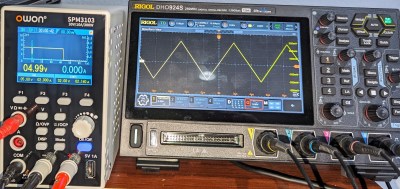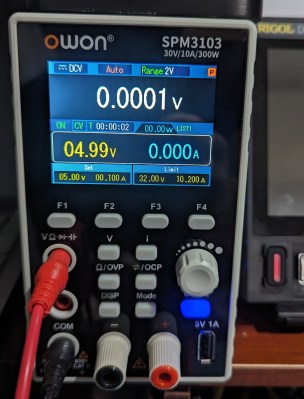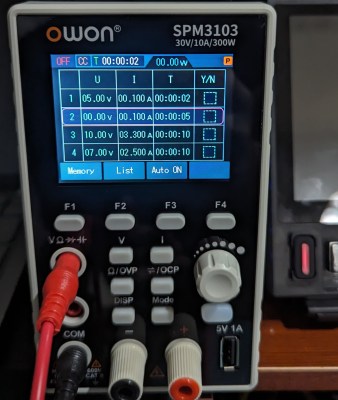Imagine an electronics lab. If you grew up in the age of tubes, you might envision a room full of heavy large equipment. Even if you grew up in the latter part of the last century, your idea might be a fairly large workbench with giant boxes full of blinking lights. These days, you can do everything in one little box connected to a PC. Somehow, though, it doesn’t quite feel right. Besides, you might be using your computer for something else.
I’m fortunate in that I have a good-sized workspace in a separate building. My main bench has an oscilloscope, several power supplies, a function generator, a bench meter, and at least two counters. But I also have an office in the house, and sometimes I just want to do something there, but I don’t have a lot of space. I finally found a very workable solution that fits on a credenza and takes just around 14 inches of linear space.
How?
How can I pack the whole thing in 14 inches? The trick is to use only two boxes, but they need to be devices that can do a lot. The latest generation of oscilloscopes are quite small. My scope of choice is a Rigol DHO900, although there are other similar-sized scopes out there.
If you’ve only seen these in pictures, it is hard to realize how much smaller they are than the usual scopes. They should put a banana in the pictures for scale. The scope is about 10.5″ wide (265 mm and change). It is also razor thin: 3″ or 77 mm. For comparison, that’s about an inch and a half narrower and nearly half the width of a DS1052E, which has a smaller screen and only two channels.

If you get the scope tricked out, you’ve just crammed a bunch of features into that small space. Of course, you have a scope and a spectrum analyzer. You can use the thing as a voltmeter, but it isn’t the primary meter on the bench. If you spend a few extra dollars, you can also get a function generator and logic analyzer built-in. Tip: the scope doesn’t come with the logic analyzer probes, and they are pricey. However, you can find clones of them in the usual places that are very inexpensive and work fine.
There are plenty of reviews of this and similar scopes around, so I won’t talk anymore about it. The biggest problem is where to park all the probes.
The Little Box

So what’s the other box? Well, it is hard to categorize. It is a power supply. But it is also a multimeter. It also has at least one other unusual feature for a power supply. The unit is the diminutive OWON SPM3103. There are several similar models that have different voltage and current capabilities and — for a power supply — none of them are inexpensive, but you can find them for just over $100 if you shop.
At first, it looks like the usual cheap power supply you see everywhere. However, it is quite different. It has a color screen. You can switch the screen to show the power supply output or use it as a bench meter. However, it is more than just a power supply with a meter jammed in.
There are several types of screens you can select using the buttons on the power supply’s front. You can, of course, display a standard power supply screen that shows volts and amps. You can set the voltage and the current limit, too. It makes sense, too, that you can select a meter screen that has a bar graph and 20,000 counts.
The meter has all the features you’d expect: autoranging (if you want it), continuity, capacitance, and a diode test. It also has hold and delta functions.

However, you can also select a screen that shows you both screens at once. There’s also a graph output that shows voltage and current from the supply over time which is handy.
There are a few other tricks. You can control the device via USB using SCPI. You can also save and load a few preset slots so you can’t switch between settings quickly. There’s also a ten-step memory that lets you define a “program.” For example, you might make step 1 start at 12V with a 5A current limit for 2 seconds to allow something with a high surge current to start. Then you could to 13.8V at 1A for the next 24 hours.
[Kerry Wong] reviewed a similar device in a video last year. You can watch it below. It works well, although the user interface takes a bit of time to get used to. There are a few quirks you can see in the video.
So those two boxes give you a capable bench in a very small space. Still plenty of desk space for a portable soldering iron, a device programmer, or a development board. Just to recap, the setup has a four-channel mixed-signal scope that can also act as a frequency counter, a spectrum analyzer, and it has a built-in signal generator. It also has a 20,000-count meter and power supply. There’s even a 1 amp USB power connector if you need it. Not bad for less than half of my credenza.
What else would you add to your ultimate tiny bench? If you have a Rigol scope like this one, WiFi is an option. If you want to orchestrate both instruments, you’ll need some SCPI skills. If you insist on using a laptop, there are plenty of multifunction boxes out there that can turn a computer into a reasonable test instrument.

















Putting a banana in the picture is a good idea. Why didn’t you?
Would it have been a metric or imperial banana?
Yup that Rigol scope is the bomb. I have sold all my other scopes, and that is now my goto scope, and they included all the options… Mine is the 924, allowed me to rid myself of many of the Function gens I’ve accumulated, including an old Wavetek… Great article.. I enjoy your writings… Thanks
Yeah I got tired of halfwaying it to save a few bucks and did the 924S also. Be sure to put a WiFi dongle in the front panel. Big help.
I had that owon power-supply, had to return it, way too much noise. Went for a Riden RD6006 instead.
I went even smaller – I have a DSO Nano, a power supply and a fluke handheld meter on my computer table and it covers me 80% of the time.
Granted I don’t do a lot of in-depth work anymore and almost no analog.
That’s not a bench, that’s a backpack! (Or could be if you brought batteries for the supply…)
Most of the time I am using Hantek 2d72 – multimeter/scope/AWG. It is pretty compact, but still enough for almost every task that I have. My Rigol scope left the desk and I used it just once or twice for past year or so.
Honestly I have the little OWON scope meter and it is also a nice compact tool. But it needs charging and “only” has 2 channels (man have we gotten spoiled).
Charging? I just keep it connected to power. Agree, that 2 channels not that much, but for more complex analysis I attach logic analyzer to the board. Anyway, device from the subject is interesting. I rarely need power supply, so standard big 2-channel box is just waste of space for me.
That power supply with meter really makes me think twice, but I notice that you have to go through sub-menus to get at any of the functionality. #firstworldproblems, but I really like knob-per-function whenever it’s possible.
OTOH, when they do a revision that adds voltage and current-limit knobs, I’ll compromise. I don’t mind having all the meter stuff, that I use less frequently, behind a menu.
The UI is a little wonky. As Kerry pointed out, they put the ground plug in the wrong place, too. But you get used to it. The nice thing is with the memories if you have a normal set up (5V 1A, 12V 5A, etc.) you just stick in the memory one time and then BAM easy to get to.
The knob doesn’t really take a menu, just a button push of a dedicated button. But still, yeah. Of course, SCPI, so put some encoders on an Arduino and go to town.
Did they figure out which way time goes on a graph yet?
Well a power-supply/signal generator built into a breadboard would be something.
Those used to be pretty common. Global Specialties. Heathkit. That would be a cool thing to bundle one of these “all in one” USB instruments into a breadboard… hmm…
Like this?:
https://digilent.com/shop/analog-discovery-studio-a-portable-circuits-laboratory-for-every-student/
Not cheap, but I am a big fan of the Analog (and Digital) Discovery devices. I’ve been a happy user since the original AD1 way back in the day. I’m the person who asked Digilent to send one to Dave Jones at EEVBlog, and he did ultimately review it (very favourably).
I can imagine a laptop-form device with a scope in the lid and controls, sockets and breadboard in the base. But I am lucky enough to have a olde-worlde workshop, so I have no need for one!
The Rigol DHO800 is not much thicker than a laptop and still has twiddly controls. You can even get one with a built-in function generator and logic analyzer.
Well, nice but there will always be room on my bench for my Flukes.
That’s what my big bench is for…
Why the obsession with scopes, bench multimeters & power? No “here’s my setup” seems complete with that trifecta, possibly add in a signal generator as well. Is it only people doing high-end analog / digital signal work that have a workbench worth taking a picture of? How often do people really need to chase a value changing in the MHz range or live decode SPI or I2C? Does this not give people starting out totally the wrong impression of what it takes to start out? Where are the more pragmatic workbench pictures?
I think it’s because other tools are smaller and can be put away. Scopes and stuff are bigger and dangle wires. So the more advanced your setup becomes, the less mobile it becomes, but also the cooler it looks.
The real minimum is a soldering iron, a multi-meter, and components. Hardly a benchfull.
I learnt to use these tools at university so maybe I’m not the sort of beginner you’re thinking of but I think you basically need then for anything more advanced than blink.ino sketch.
Without a scope you are blind to what your circuit is actually doing so when it’s not doing what you expect you’re lost. The cheapest multimeter will serve until you need something better. A power supply is essential for driving motors.
Reading r/askelectronics it seems like beginners are having major problems because they lack these tools.
My philosophy is to buy as cheap as you can and upgrade if you find you need to our you use it enough to break it.
> I think you basically need then for anything more advanced than blink.ino sketch.
That just feels so wrong – you can do an insane amount with I2C, SPI, OneWire sensors, onboard ADC, PWM, GPIO, Interrupts and so forth using any number of the smaller pin MCU – say up to QFN-32 soldered to a breakout board plugged in to a breadboard and not even need your multimeter. A couple of AA cells for power and you are away.
I guess I’m wondering what sort of mess you have to get in to or what sort of high end design that needs a ‘scope. A DHO924S is one thing, but one YouTuber sports a MSOX3054T which he uses to show off PWM from an MCU a few days ago.
The kit recommendation that gets the best ooooh’s and arrrrrh’s is when I lend someone my side cutters (for ten minutes, under close supervision) – that’s a £50 investment they make immediately. I guess the basics just aren’t sexy enough.
Exactly, I have programmed some pretty complex projects, drones, robots, etc and have never had to use my oscilloscope on them. Most of the time the problem is with your code or wiring and oscilloscopes aren’t going to help much with that.
In all of my time programming microcontrollers, including programming drones, robots, etc, I have never had to use an oscilloscope. Now I have used a logic analyser a few times but only a few and mainly when working with FPGAs.
Oscilloscopes just aren’t all that useful for most digital electronics, oscilloscopes are good for helping debug analogue issues, most of the time when using MCUs if something isn’t working it is your code or wiring that isn’t right, not an issue with the analogue component of the signals themselves and as such connecting up an oscilloscope is rarely that useful.
It would be very rare to have an issue with the analogue component of uart, SPI or I2C, most of the issues are caused by and solved by your code. Sure you can look at the oscilloscope to decode what is actually being sent or received but there are other ways of doing that.
Most of the time with MCUs you do not need to see what the circuit is actually doing and there are better ways of debugging your circuit and code anyway so you are far from lost if you don’t have an oscilloscope.
For most hobbyist or beginner MCU work a cheap logic analyser will be more than enough and even then it often isn’t needed.
Power supplies are important though, however for a hobbyist wanting to power a few motors battery packs can be better.
Reminds me when we went on a two week debugging spree down to kernel level because the workstations were not able to access the printer … turned out the network cable was not completely plugged in.
My workspace isn’t dedicated to electronics. Between projects, everything goes back on the shelf, and tools back on the pegboard. Unpacking and repacking the tool boxes is time consuming though. I’m thinking about trays for electronics. Tray #1 could be soldering iron, helping hands, multi-meter, and fume extractor. Tray #2 could be parts and components like wires, LEDs, etc. Finally one tray per project so I can (literally) pick-up and put-down projects instead of occupying the entire craft bench.
And than a system of drawers below the table to quickly swap trays. I was planning to make a workbench for my garage – you just gave me idea to organize stuff on it. I will look for trays with covers for dust protection.
Thanks!
Depending what you work on, capacitance and inductance measurement is useful.
Sure, with sig gens and multimeters you could cobble something together, but there’s a lot to be said for just selecting a menu option.
The meter does some cap measurement. No inductor though…
LCR T4 is small enough and does a lot other measurements. Also comese with many form factors and revisions.
The analog discovery 3, despite needing a computer or laptop to connect to can do that if you get the impedance measuring attachment or build the measuring circuit yourself.
It is a 125 MS/s 2 channel scope and wavegen, a 125 MS/s 16 channel logic analyser and pattern generator and programmable power supply all combined.
It has a few other modes that use the scope and wavegens like the network mode where it can do a frequency sweep of a circuit and measure the results, or the impedance mode where it can measure the impedance of a circuit or component or the curve tracing mode where it can curve trace transistors, diodes, etc.
Overall it is a very compact but capable tool, it isn’t cheap though but for something small enough to fit in your pocket and have all those features it is worth it if you don’t need very high performance. The best thing about it though is how the individual sections can be combined and synchronized, you can have all the instruments start at the same time, trigger each other, etc and it can be scripted too.
Chances are you need a laptop with you anyway, regardless of what you are actually doing and you are unlikely to need high performance equipment for most uses, so USB instruments can be very useful and very compact.
Like the Analog Discovery 3, it is a 2 channel scope, a 2 channel sig gen, a 16 channel logic analyser and pattern generator, an adjustable power supply and a few other things. If is very compact but if is still very capable. Also with the AD3 you can combine two together to synchronize them and therefore get a 4 channel scope which is expensive but still very compact and portable.
Everyone on my team at work is given a Saleae Logic 16 Pro. We looked at changing our standard issue to the much cheaper AD3 because of the PSU and (better) scope functionality. Sadly it won’t work for us as we work mostly with 1.8V devices and the AD3 logic analyzer is 3.3V LVCMOS thresholds.
If they released an Analog Discovery 4 at twice the price while only adding programmable digital thresholds, it would still be a bargain in comparison to Saleae.
We’re working on low cost probes for the rigols over here. https://www.eevblog.com/forum/testgear/another-low-cost-la-probe-for-rigol-mso5000-by-oliv3r/100/ not fully do e yet ( reds a test run still) but quite happy with the design so far.